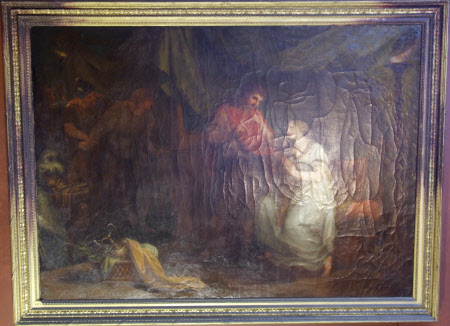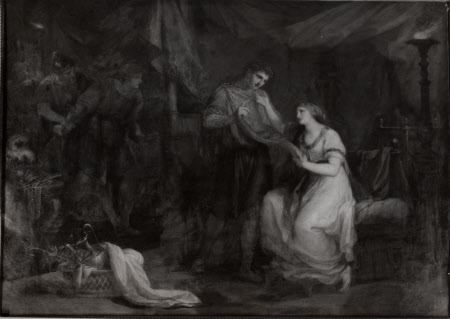Diomed and Cressida (from William Shakespeare’s ‘Troilus and Cressida’, Act V, scene ii)
Angelica Kauffman RA (Chur 1741 – Rome 1807)
Category
Art / Oil paintings
Date
1789
Materials
Oil on canvas
Measurements
1580 x 2220 mm (62 ½ x 87 ½ in)
Place of origin
Rome
Order this imageCollection
Petworth House and Park, West Sussex
NT 486152
Caption
This and the companion painting, Two Gentlemen of Verona, Act V, Scene III, now in the Courtauld Institute, were done in Rome for Boydell’s Shakespeare Gallery through the intermediary of Thomas Jenkins, in 1789. The scene is taken from Shakespeare’s Troilus and Cressida, Act V, scene II, outside the tent of Calchas, where the meeting of Diomedes and Cressida is witnessed by Troilus, Ulysses and Thersites. The picture was bought at Boydell's sale, in 1805, by Sir William Burrell for £73.10s. and left in his will to the 3rd Earl of Egremont (1751-1837).
Summary
Oil painting on canvas, Diomed and Cressida (from William Shakespeare’s ‘Troilus and Cressida’, Act V, scene ii) by Angelica Kauffman RA (Chur 1741 – Rome 1807), 1789. Cressida is seated, right, holding Diomed's left hand. He stands facing her with, in the left foreground, a basket and in the left background, two figures. The scene takes place outside the tent of Calchas, where the meeting of Diomedes and Cressida is witnessed by Troilus, Ulysses and Thersites. The companion painting, Two Gentlemen of Verona (Act V, Scene III), was done in Rome for John Boydell I (1719 – 1804) through the intermediary of Thomas Jenkins, in 1789.
Provenance
Painted in Rome in 1789 for Boydell's Shakespeare Gallery. Bought at Boydell's sale, Christie's, 20 May 1805 by Sir William Burrell for £73.10s. and left in his will to the 3rd Earl of Egremont (1751-1837); thence by descent, until the death in 1952 of the 3rd Lord Leconfield, who had given Petworth to the National Trust in 1947, and whose nephew and heir, John Wyndham, 6th Lord Leconfield and 1st Lord Egremont (1920-72) arranged for the acceptance of the major portion of the collections at Petworth in lieu of death duties (the first ever such arrangement) in 1956 by HM Treasury.
Credit line
Petworth, The Egremont Collection (Natioanl Trust)
Makers and roles
Angelica Kauffman RA (Chur 1741 – Rome 1807), artist John Boydell I (Dorrington 1719 – Cheapside, London 1804), commissioner


